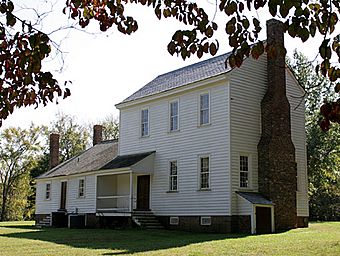Stagville facts for kids
Quick facts for kids |
|
|
Stagville
|
|
 |
|
| Location | 5828 Old Oxford Highway, Durham, North Carolina |
|---|---|
| Area | 9 acres (3.6 ha) |
| Built | 1799 |
| Architectural style | Georgian |
| NRHP reference No. | 73001338 |
| Added to NRHP | May 25, 1973 |
Stagville Plantation is a very old place in Durham County, North Carolina. It has buildings from the late 1700s and mid-1800s. Stagville was once part of a huge group of farms, called a plantation complex, in the American South.
These lands were owned by the Bennehan, Mantack, and Cameron families. By 1860, this complex covered about 30,000 acres (about 121 square kilometers). Nearly 900 enslaved African Americans lived and worked there.
Today, Historic Stagville is a special site that helps us understand North Carolina's past. It shows us what life was like in the South before the American Civil War.
Contents
What Can You See at Stagville?
The historic site of Stagville covers about 71 acres (about 287,000 square meters). It includes several old houses and barns. You can see the original Bennehan House and some of the homes where enslaved people lived. These homes were in an area called Horton Grove.
The Bennehan House
The Bennehan House was first built in 1787. A large part was added in 1799. This house was recognized as an important historical place in 1973. It is listed on the National Register of Historic Places.
Horton Grove Slave Quarters
Horton Grove is an area with two-story homes built in 1850. These were homes for enslaved people. They are very well preserved and are the only two-story slave quarters still standing in North Carolina. This area was also listed on the National Register of Historic Places in 1978.
Archaeologists have found many interesting things around these quarters. These discoveries help historians learn about the daily lives of the many enslaved people. They show us how these individuals lived and worked at Stagville and on other lands owned by the Bennehan-Cameron families.
Stagville Today: A Historic Site
In 1976, a company called Liggett and Meyers Tobacco Company owned the land. They gave some of it to the state of North Carolina. Now, the state runs the property as Historic Stagville State Historic Site.
It is like a historic house museum where you can visit and learn. The North Carolina Department of Natural and Cultural Resources manages this important historical place. It helps people understand a significant part of North Carolina's history.



